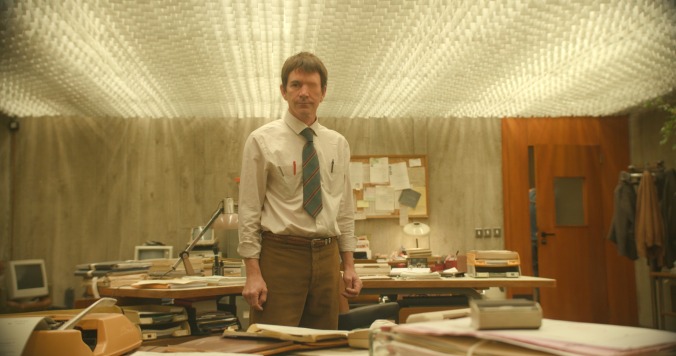Cop comedy Keep An Eye Out has the anything-goes absurdity of a closing SNL sketch

Note: The writer of this review watched Keep An Eye Out on a digital screener from home. Before making the decision to see it—or any other film—in a movie theater, please consider the health risks involved. Here’s an interview on the matter with scientific experts.
Like a Saturday Night Live sketch that airs in the show’s final 10 minutes, Quentin Dupieux’s Keep An Eye Out tosses around ridiculous comic ideas as if secure in the knowledge that few people will ever see them. This quasi-surrealistic “What the hell?” approach can be glorious, painful, or some combination of the two; it also risks a lot less at just four or five minutes than it does at feature length (though this film runs barely over an hour if you subtract its slow-scrolling end credits). So there’s something to be said for Dupieux’s ability—previously showcased in such whatsits as Deerskin (actually made after Keep An Eye Out, though released first in the U.S.), Reality, and Rubber—to keep viewers engaged in a story that keeps veering in utterly wild directions, without ever necessarily having a coherent destination in mind. The result can be frustrating, but it’s rarely dull.
This particular example suffers a bit from visual monotony, as most of it takes place in a French police office that’s notable mostly for its blinding array of overhead fluorescent lights. There, Chief Inspector Buron (Benoît Poelvoorde, a Belgian actor still best known in the States for starring in and co-directing 1993’s Man Bites Dog) interrogates a murder suspect, Louis Fugain, who insists that he simply found a dead body outside his apartment building and phoned the authorities. In theory, the film’s narrative consists of a painstaking reconstruction of his actions on the night in question, which raised suspicion because A) a nosy woman in his building saw him leave it and return no fewer than seven times between midnight and dawn, and B) Fugain’s iron, of all things, was found beside the corpse, which had had its skull split open. Fugain has perfectly rational explanations for everything, though he decides not to take any chances with the other dead body that he’s stuffed into one of the police lockers when Buron is out of the room.
Wait, what?! Attempting to describe what happens in any Dupieux movie is an exercise in futility. Here he’s interested in the murder plot only insofar as he can employ it as a springboard for general nuttiness, which commences when another policeman (Marc Fraize), whose desk faces away from the camera, turns in response to a question and reveals a smooth expanse of skin where his left eye—or even just his left eye socket—should be. Later, tendrils of smoke rise from Buron’s chest as he puffs on a cigarette; when Fugain expresses alarm, Buron tells him that it’s just a hole, no big deal. Many of these poker-faced absurdities are quite funny, and a few are so inspired that Dupieux might have done better to run with one of them, rather than serving up a smorgasbord of disconnected weirdness. His idea for flashbacks to the night of the crime, in particular, involves a truly delightful logical paradox that sees people from Fugain’s present invade his memories of the recent past, asking pointed questions about the future. That concept could have been built into something elaborately gonzo, but Dupieux prefers to have someone eat an entire oyster, shell and all, as if it were the world’s crunchiest taco. The movie concludes with a Twilight Zone-style twist, which, while fun and surprising, is no less random than everything else. This filmmaker’s madness could use just a little more method.